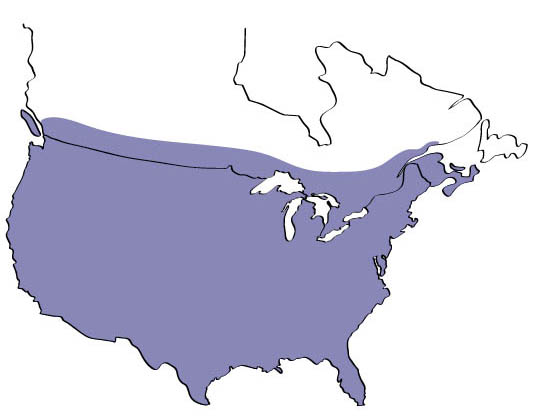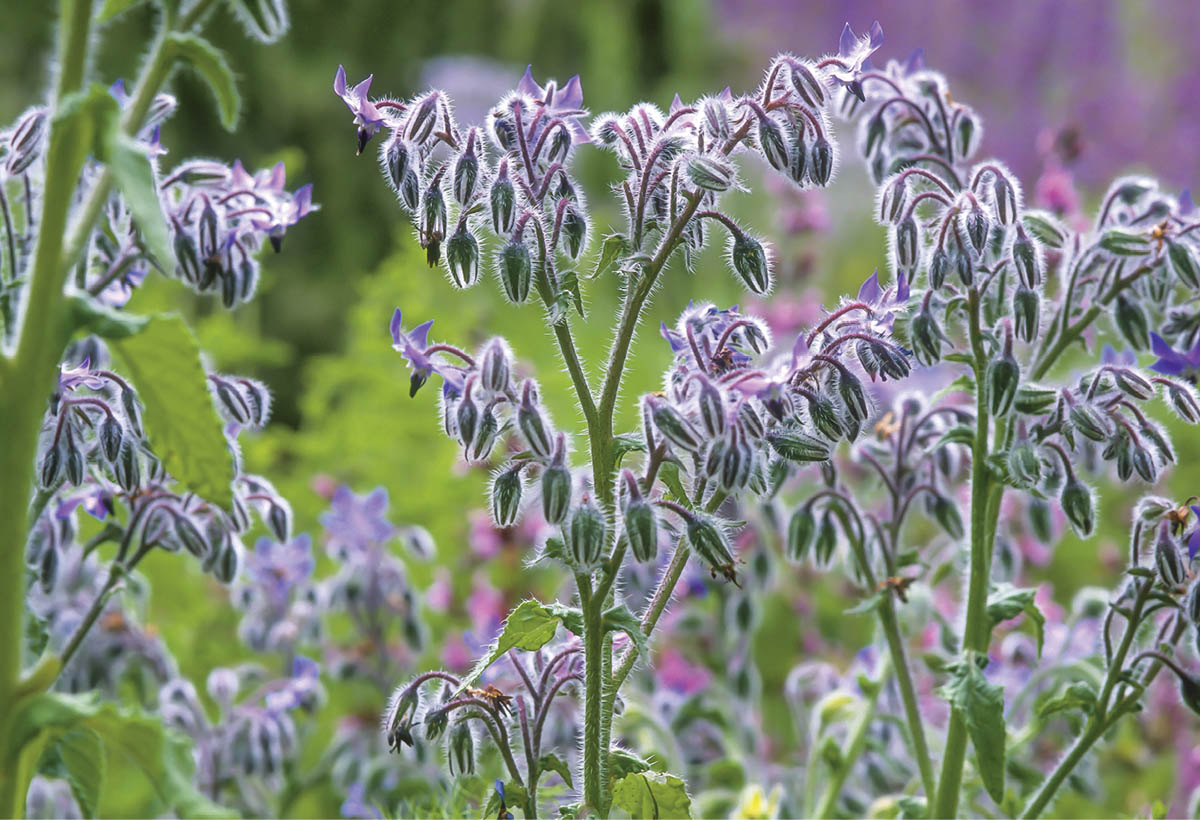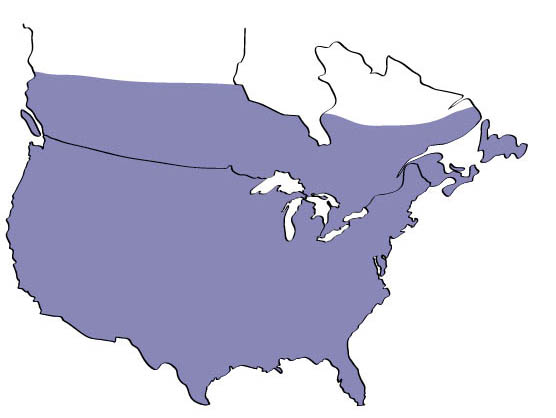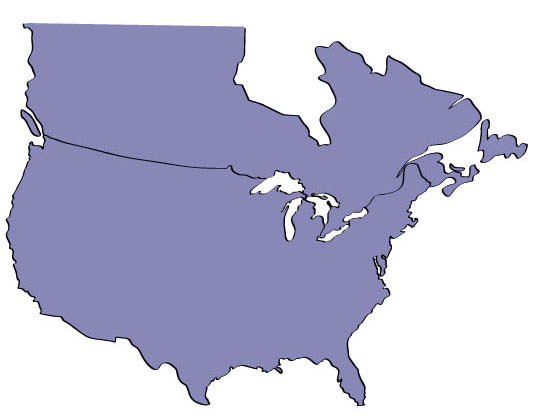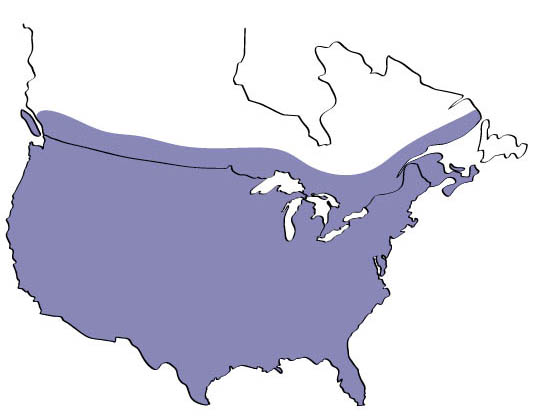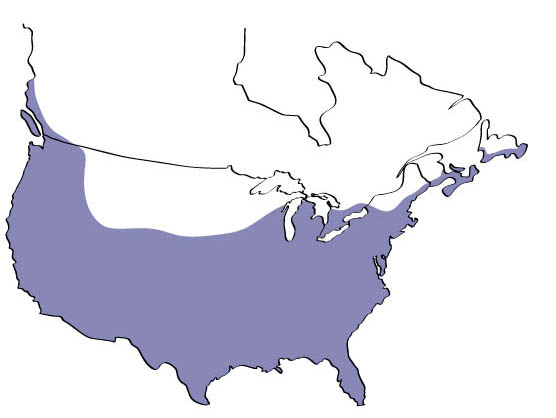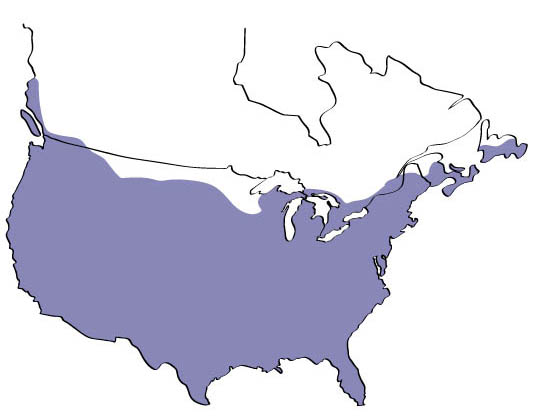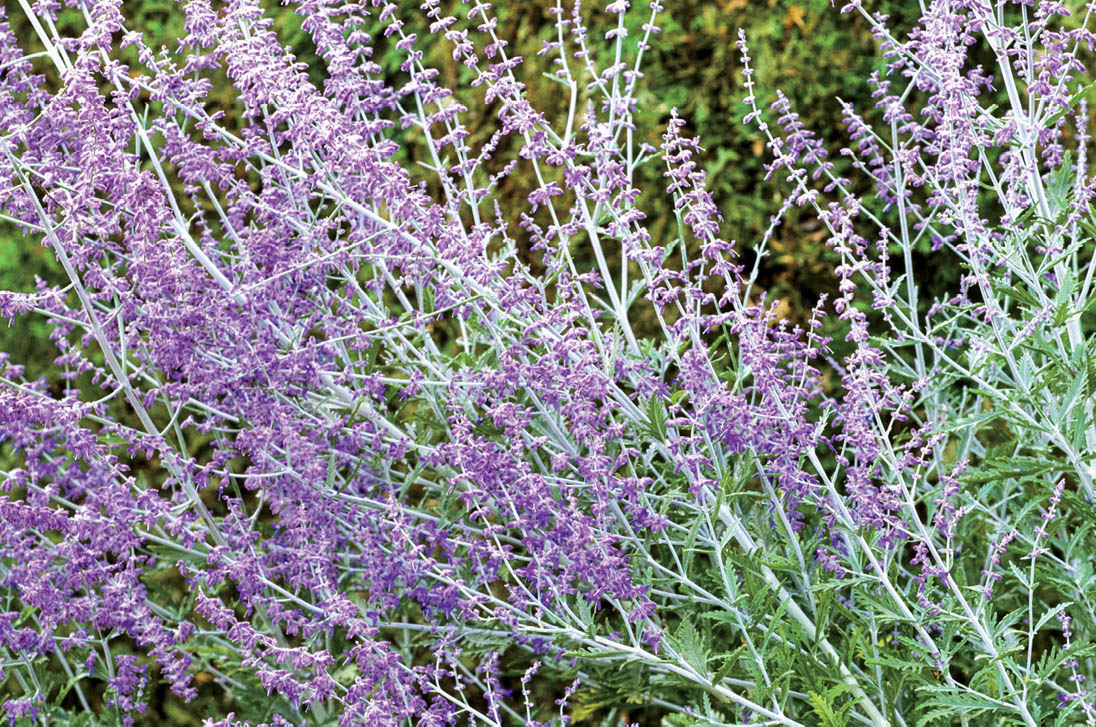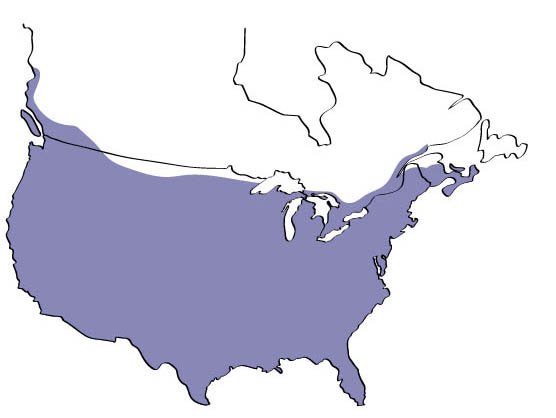78.
Basil
(Ocimum spp.)
An easy-to-grow annual, common sweet basil (Ocimum basilicum) supports bee visitors — but only if allowed to bloom. Like most kitchen herbs, it attracts a wide range of showy and beneficial insects while remaining largely pest-free itself. Inexpensive and easily available, basil is a good candidate for including in the home garden as a temporary insectary strip: a row of quick-flowering annuals sown between other food crops to attract beneficial insects for both pollination and pest control. At Xerces we’ve used basil, along with coriander and dill, to produce a simple insectary strip that blooms quickly and provides an ongoing source of herbs for the kitchen.
For maximum pollinator attractiveness, basil is most effective in massed plantings. Lone individual plants are not likely to attract much attention in the home garden when other summer-blooming plants such as sunflowers are nearby. Basil is very susceptible to frost and cold-weather injury. In cold climates, start transplants indoors for earlier-flowering plants.
Recommended Species or Varieties
Holy basil (Ocimum tenuiflorum) and many cultivated varieties of O. basilicum are readily available. Potentially better for attracting pollinators, lemon basil (O. × citriodorum) is a hybrid with typically larger, showier flowers.
Notable Flower Visitors
When planted in masses and allowed to flower, attracts bumble bees, a variety of small wild sweat bees (Halictus spp.), small beneficial (aphid-eating) syrphid flies, tiny beneficial wasps, and honey bees.
Uses
- Ornamental
- Edible/herbal/medicinal
Exposure: Sun
Soil moisture: Average
Bloom time: Summer
Flower color: White
Maximum height: 2 feet (0.6 m)
79.
Borage
(Borago officinalis)
Attractive star-shaped flowers turn from blue to pink on borage as they age, adding an interesting shape and texture to the garden. This annual Mediterranean herb is now occasionally cultivated as a field crop for oil (used in the cosmetics industry) and for naturopathic medicine. More commonly it’s grown as a garden plant, especially in Europe, where it has historically served as a food plant, but it grows well across most of North America as well. Both flowers and leaves are edible.
For longer bloom periods, stagger the seeding dates. Borage will adapt to many soil types, but grows largest and flowers most prolifically in rich, fertile soils. The sugar in its nectar has been measured at 52% and produces a dark honey. Borage apparently secretes nectar throughout the day, and continues to yield even in cold weather.
Recommended Species or Varieties
In addition to the blue-flowered species, a white-flowered cultivar is available.
Notable Flower Visitors
While bumble bees (especially species with short tongues) visit borage, it is most important as a honey bee plant. Butterflies and other flower visitors typically ignore the flowers.
Uses
- Ornamental
- Edible/herbal/medicinal
Exposure: Sun
Soil moisture: Average
Bloom time: Spring to summer
Flower color: Blue
Maximum height: 2 feet (0.6 m)
80.
Catnip
(Nepeta spp.)
Several dozen perennial and annual species of catnip are native to Europe, Asia, and Africa. Some have escaped as naturalized weeds across the United States and Canada, while a few others are planted as garden ornamentals. Under optimal conditions most catnip species bloom for an extended period, sometimes several months. They are relatively resilient to alternating cycles of hot and cold weather as well as to dry conditions, but they grow more prolifically in fertile, damp soils. While deer avoid catnip, cats do not and can make quick work of plants that aren’t protected.
The average sugar concentration reported in the nectar of catnip species ranges from 22 to 28%, and the resulting honey is dark in color and slightly spicy. While each individual catnip flower produces only a tiny amount of nectar, plants can produce a reliable honey surplus when grown in large masses.
Recommended Species or Varieties
All types of catnip are generally good bee plants, including the common true catnip (Nepeta cataria). The ornamental hybrid Faassen’s catnip (N. × faassenii) is frequently planted as a ground cover or garden border plant; it grows and flowers prolifically, attracting huge numbers of honey bees and bumble bees.
Notable Flower Visitors
Attracts honey bees and bumble bees most commonly.
Uses
- Ornamental
- Edible/herbal/medicinal
Exposure: Sun
Soil moisture: Average to dry
Bloom time: Spring to summer
Flower color: White, blue
Maximum height: 2 feet (0.6 m)
81.
Coriander
(Coriandrum sativum)
Also known as cilantro, coriander is an annual herb native to Asia and North Africa. Its flowers bloom for a long period (sometimes more than a month) and produce large amounts of nectar, although it is low in sugar concentration. Coriander is often included in commercial seed mixes for beneficial insects, and organic farmers have widely adopted it for interplanting in an insectary strip among other cash crops.
Recommended Species or Varieties
Various cultivars have been developed, including the slow-to-flower ‘Calypso’ and ‘Marino’. For pollinators, any low-cost, fast-flowering variety is fine.
Notable Flower Visitors
Honey bees and paper wasps (Polistes spp.) are the largest insects typically observed. A closer look will reveal large numbers of tiny dark sweat bees (Lasioglossum spp.), small aphid-eating syrphid flies, and many types of small beneficial wasps.
Exposure: Full sun to partial shade
Soil moisture: Dry to moist
Bloom time: Summer
Flower color: White, pink
Maximum height: 3 feet (1 m)
82.
Cosmos
(Cosmos bipinnatus)
A popular, low-cost summer- and fall-blooming garden annual, cosmos thrives in fairly poor soils as long as it has minimal competition, adequate soil moisture, and full sun. This member of the sunflower family is most effective at attracting pollinators when mass-planted to create large blocks of color in the landscape. Researchers in New Mexico have successfully used cosmos in combination with a few other inexpensive annuals (including dill, buckwheat, California bluebells, alyssum, and plains coreopsis) as an insectary plant with pumpkin crops, supporting predators of the squash bug and spotted cucumber beetle.
Recommended Species or Varieties
Many varieties of cosmos offer variations in color, height, petal shape, and early flowering. To attract pollinators, select simple, flat-petaled varieties in pink or white; avoid those with double petals.
Notable Flower Visitors
Attracts various bee species that are active in summer, including green metallic sweat bees (Agapostemon spp.) and long-horned bees (Mellisodes spp.). The latter bees tend to be specialists of the sunflower family and are most active in late summer, when cosmos is in full bloom. It is not uncommon to find male long-horned bees clustered on cosmos plants, forming overnight “bachelor parties” gathered around flowers and along plant stems. This might be a way of conserving body heat, allowing the bees to become active earlier on cool mornings.
Exposure: Sun
Soil moisture: Average
Bloom time: Summer to autumn
Flower color: White, pink, red
Maximum height: 4 feet (1.2 m)
83.
Hyssop
(Hyssopus officinalis)
Traditionally, hyssop was mass-planted as a honey plant, and in parts of the Middle East it is reportedly still an important source of honey, yielding more than 150 pounds per colony under good conditions. In North America it continues to live up to its reputation as a honey bee plant, although it is not widely planted today. True hyssop (not to be confused with wild anise hyssop, Agastache spp., is a small, aromatic, lavender-like shrub native to Southern Europe and the Middle East, where it has been used since biblical times as a kitchen herb and medicinal plant.
Hyssop is widely thought of as drought tolerant, but in our experience that seems true only on loose, well-drained soils where the plant can extend deep roots to extract water. Under good conditions this plant should reseed and spread over time to cover more ground, as long as it has space.
Recommended Species or Varieties
Though pink- and white-flowered forms are available, the blue-flowered is the most common, and the one with which we at Xerces have had the most success.
Notable Flower Visitors
Attracts honey bees and occasionally butterflies, bumble bees, and even hummingbirds in areas where it grows prolifically.
Uses
- Ornamental
- Edible/herbal/medicinal
Exposure: Full sun to partial shade
Soil moisture: Average to dry
Bloom time: Mid- to late summer
Flower color: Blue, pink, white
Maximum height: 2 feet (0.6 m)
84.
Lavender
(Lavandula spp.)
In Europe, lavender is considered among the most important honey plants, especially in France, where its association with beekeeping is famous. Aside from the connection to honey bees, these small evergreen Mediterranean and Middle Eastern shrubs are of course equally famous for culinary and cosmetic uses. Lavender thrives in dry climates with well-drained soil (it is perfectly at home in gravel soil, for example), but it tends to suffer in cool, high-humidity climates, especially when subjected to shade. It’s a good candidate for xeriscape gardens.
The sugar concentration of lavender nectar has been recorded at concentrations from 14 to 67%; the resulting honey is golden and readily granulates into small crystals, creating a smooth, butterlike texture. Beekeepers have reported 40 pounds of surplus honey per colony near commercial lavender farms.
Recommended Species or Varieties
Several species including English lavender (Lavandula angustifolia) and French lavender (L. dentata). Various cultivated varieties and hybrids exist, including pink- and white-flowered varieties.
Notable Flower Visitors
All lavenders are productive bee plants, commonly attracting honey bees, mason bees (Osmia spp.), small carpenter bees (Ceratina spp.), bumble bees (Bombus spp.), and both native and nonnative wool carder bees (Anthidium spp.).
Uses
- Hedgerow
- Ornamental
- Edible/herbal/medicinal
Exposure: Sun
Soil moisture: Dry
Bloom time: Summer
Flower color: Purple, pink, white
Maximum height: 3 feet (0.9 m)
85.
Mint
(Mentha spp.)
Most true mints are not native but were introduced to North America, although at least one native species is widely distributed, the wild field mint (Mentha arvensis). Nearly all prefer rich, damp soils, such as cool stream banks. A few are less picky and will adapt even to sunny, well-drained locations. Many mints spread by underground rhizomes and can be aggressive under optimal conditions; many of the most aggressive species, however, such as the introduced peppermint (Mentha × piperita), are sterile hybrids unlikely to reseed themselves. Surplus honey production approaching 200 pounds per colony has been documented near commercial mint fields. The honey is amber in color and easily granulates, with very small crystals.
Recommended Species or Varieties
Of the more than 200 species of true mints (including hybrid), the two that we at Xerces are most familiar with are the common garden spearmint (M. spicata) and the native wild field mint (M. arvensis). We wish seed of this latter species were more widely available for habitat restoration projects.
Notable Flower Visitors
Attracts honey bees, bumble bees, many types of beneficial flies and wasps, and countless small native bees.
Uses
- Wetland restoration
- Farm buffer/filter strip
- Edible/herbal/medicinal
Exposure: Sun to shade
Soil moisture: Average to wet
Bloom time: Summer
Flower color: White, lavender
Maximum height: 1.5–2 feet (45–60 cm)
86.
Oregano
(Origanum spp.)
Like other Mediterranean kitchen herbs, oregano prefers sunny locations and fairly dry, alkaline soils. It is a member of the mint family, as are many other herbs. And while many oreganos are more cold-tolerant than some of their relatives (such as lavender and rosemary), some species are not truly cold-hardy and will not survive cold winters. In warm and moderate climates, however, oregano is a reliable, low-maintenance perennial. Its nectar has some of the highest documented sugar concentration of any plant, up to 76%. The honey produced from oregano is famous in parts of Greece (where it originates on remote mountain meadows), and the plant has been reported to yield surpluses of more than 40 pounds of honey per colony.
Recommended Species or Varieties
True oregano (Origanum vulgare) and its various subspecies and cultivars, also sweet marjoram (O. majorana).
Notable Flower Visitors
Attracts bees, especially bumble bees and honey bees.
Uses
- Ornamental
- Edible/herbal/medicinal
Exposure: Sun
Soil moisture: Dry
Bloom time: Summer
Flower color: White, pink
Maximum height: 2 feet (60 cm)
87.
Rosemary
(Rosmarinus officinalis)
A compact woody shrub with limited cold-hardiness, rosemary generally blooms in late winter through spring (depending on the climate), but sometimes flowers again in autumn. This wonderful evergreen plant with hemlocklike foliage and attractive blue flowers is well adapted to dry, exposed locations. It is well suited for xeriscape gardening and for use in hedges (at least in warm climates). Because rosemary will not survive harsh winters, in cold climates it is sometimes grown in containers, then moved inside during the winter months and maintained as a house plant.
Rosemary is a honey bee plant resource with sugar concentrations in the nectar of 25 to 63%. Up to 132 pounds of surplus honey per colony have been reported, including individual production rates of up to 15 pounds of rosemary honey per colony per day. The resulting honey is clear and water white.
Recommended Species or Varieties
Cultivars have been developed with white or pink blossoms (as opposed to the common blue ones), yellow-streaked foliage, or a low, ground-hugging growth habit. Upright varieties that produce a profusion of blue flowers, such as ‘Tuscan Blue’, are good for bees.
Notable Flower Visitors
Attracts bees most commonly, especially honey bees and bumble bees. (Note that this is true with most Mediterranean kitchen herbs in the mint family that have been introduced to North America, such as lavender, oregano, and thyme.)
Uses
- Hedgerow
- Ornamental
- Edible/herbal/medicinal
Exposure: Sun
Soil moisture: Dry
Bloom time: Spring
Flower color: Blue
Maximum height: 3 feet (0.9 m)
88.
Russian Sage
(Perovskia atriplicifolia)
A very tough nonnative perennial, covered with long-lasting spires of purple-blue blooms and silver foliage, Russian sage is ideal for difficult sites such as parking lot islands and sunny building foundations. Contrary to its common name, Russian sage is not from Russia but from south-central Asia. That geographic origin explains the plant’s adaptation to extremes of heat, cold, drought, salt, and highly alkaline soils. In very cold climates, Russian sage dies back to the ground each winter. In warmer climates, its growth is more shrublike.
Recommended varieties
Various varieties with slightly more compact growth habits have appeared on the market. All are excellent, pest- and trouble-free bee plants.
Notable Flower Visitors
Attracts bumble bees, honey bees, and wool carder bees (Anthidium spp.). There is little documentation of the plant’s honey production potential, but based on observations of honey bee visitation, Russian sage could be an important honey plant in dry climates, where large numbers are grown as ornamentals.
Uses
- Reclaimed industrial land/tough sites
- Ornamental
Exposure: Sun
Soil moisture: Dry
Bloom time: Summer
Flower color: Blue
Maximum height: 5 feet (1.5 m)
89.
Thyme
(Thymus spp.)
In Greece, where bees forage from the wild plants in their native environment, thyme and oregano are a significant and well-known source of wild honey. Thyme includes several dozen related species, most of them small, creeping evergreens that thrive in any sunny location regardless of heat or cold. In the garden they are frequently used as a ground cover, carpeting rock gardens and areas between stepping-stones. Several Xerces members use various creeping thyme species as a low-maintenance substitute for lawn grass (although the plants cannot sustain the same foot traffic as turf grass).
The average sugar concentration of thyme nectar has been recorded at 27 to 45%, with that nectar being a strong attractant. The surplus honey yields from thyme have been reported as high as 125 pounds per colony. The resulting honey is amber colored and minty smelling.
Recommended Species or Varieties
Dozens of species and cultivated varieties of thyme are available; all appear to be good bee plants.
Notable Flower Visitors
Attracts bumble bees and honey bees.
Uses
- Ornamental
- Edible/herbal/medicinal
Exposure: Sun
Soil moisture: Dry to moist
Bloom time: Summer
Flower color: Lavender, white
Maximum height: 8 in. (20 cm)



